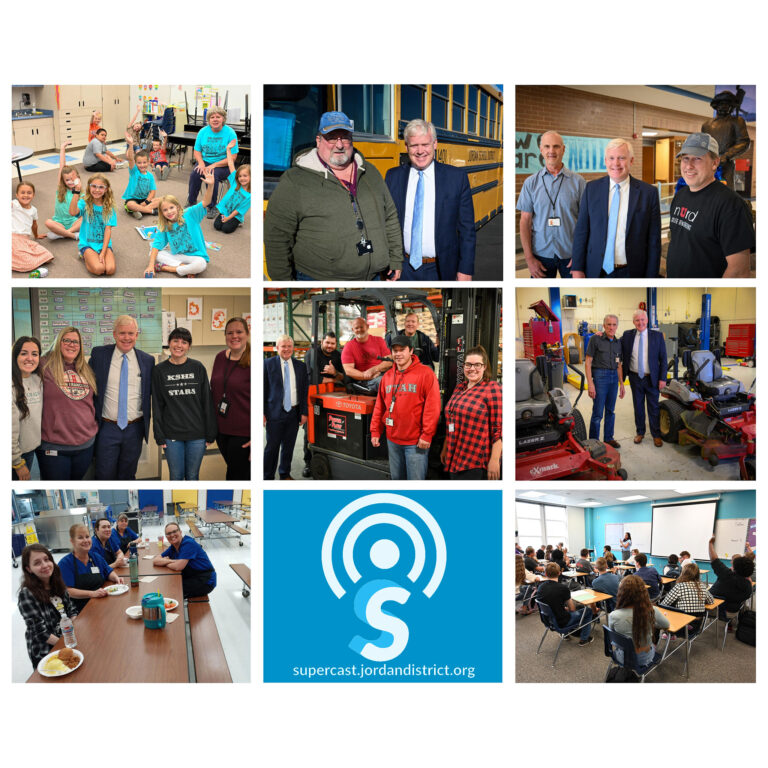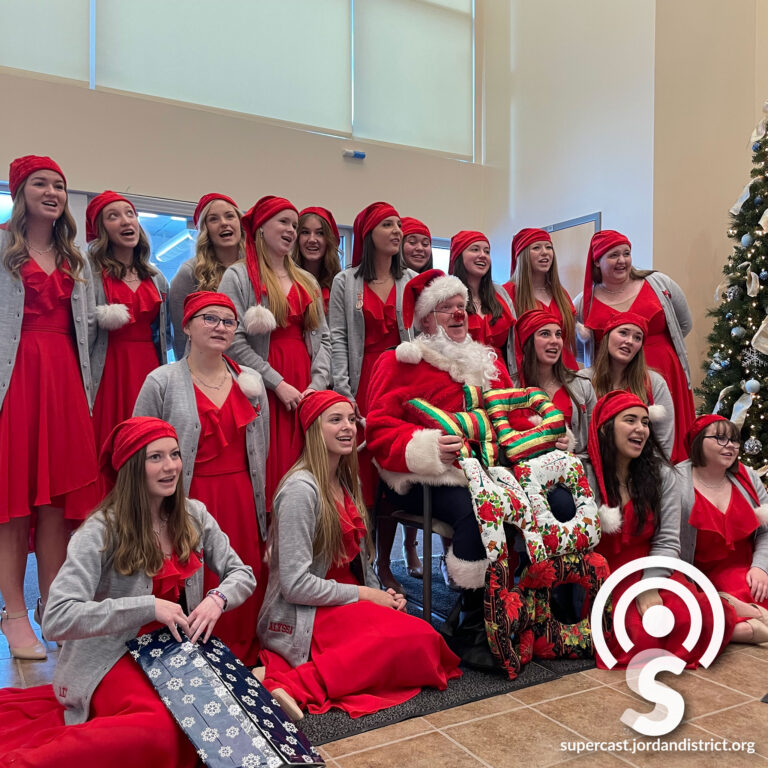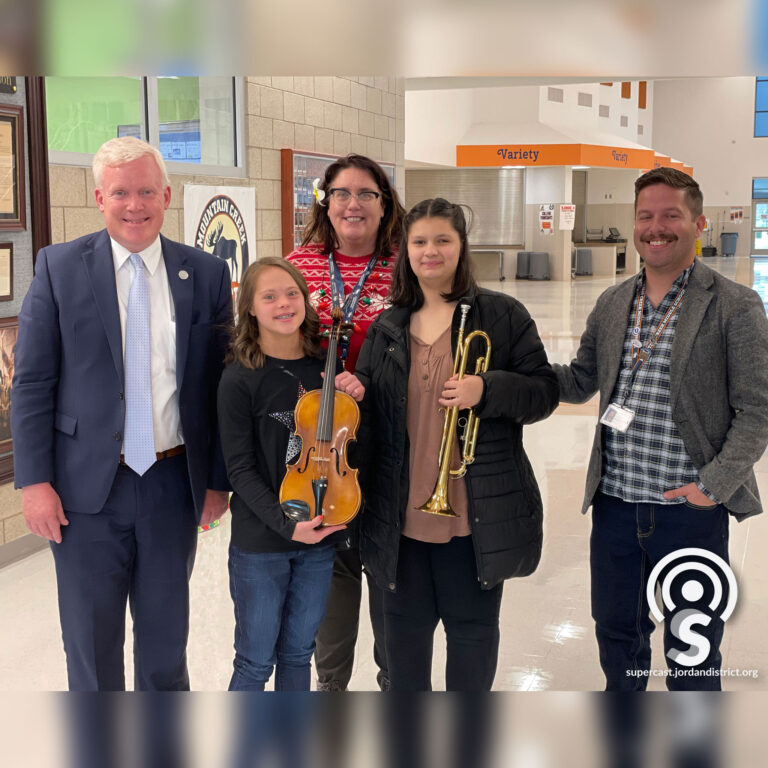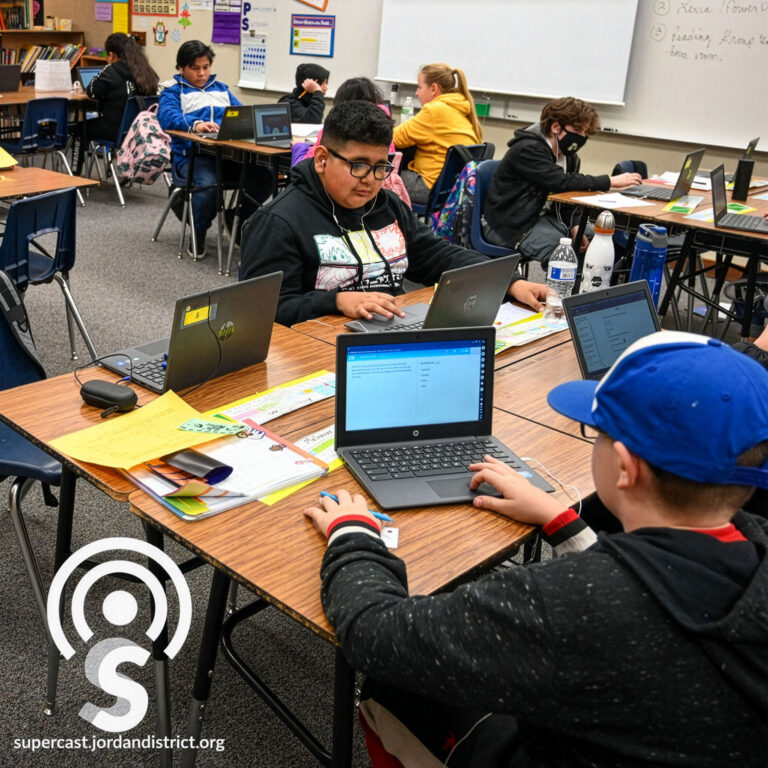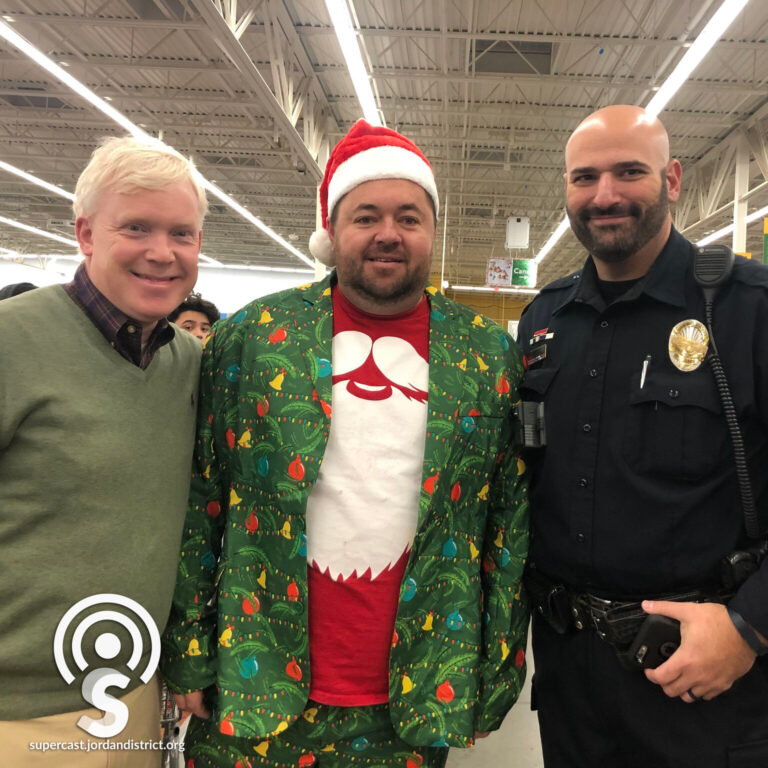Are you looking for a new career in the New Year? We may have exactly what you’re looking for. On this episode of the Supercast, we explore the job opportunities available right now in Jordan School District for those looking for full or part-time employment.
They are jobs that offer competitive pay and benefits working with some of the best people around.
Audio Transcription
Anthony Godfrey:
Hello, and welcome to the Supercast. I'm your host, Superintendent Anthony Godfrey. Are you looking for a new career in the new year? We may have exactly what you're searching for. On this episode of the Supercast, we explore the job opportunities available right now in Jordan School District for those looking for full or part-time employment. They are jobs that offer competitive pay and benefits working with some of the best people around.
Anthony Godfrey:
We're here with Brent Burge, Human Resources Administrator and Amanda Bollinger, Assistant Director of Special Education to talk about job opportunities for the new year. We have many of them, and there really are some jobs that folks may not be thinking about that are opportunities. Part-Time, full-time, benefited, non benefited positions, and we have a lot of openings and a lot of great opportunities to become a part of Jordan School District. So let's start with Mr. Burge. Can you tell us some of the different job families that we have in the district focusing on our education support professionals. Now that's the term nationally, ESP or education support professional. And really, we can't do that essential work in the classroom without them. There are lots of job families that encompass this group. So tell us, a few of those and some of the opportunities there.
Brent Burge:
Absolutely. We have a great group of people, a lot of different openings. We can start with our transportation group, whether it's bus attendants, or bus drivers. We have our custodial group, which keeps the buildings clean. We have our administrative assistant group full-time and part-time. We have our facilities group, which takes care of all of the buildings and a whole host of others.
Anthony Godfrey:
So let's start with transportation. There are bus attendants, bus drivers, and we need bus drivers more than almost any other position.
Brent Burge:
That's one of our biggest needs. Yes, you're correct.
Anthony Godfrey:
Tell me about what it looks like for someone who thinks, “Hey, maybe I'd like to be a bus driver.” What's the process like, what is the training like and what types of routes and responsibilities may be assigned to them?
Brent Burge:
Absolutely. So our transportation group, in order to be a bus driver, you have to have a CDL with a passenger and bus endorsement. Luckily our district provides that training so that employees can come in, get the training needed and start driving immediately.
Anthony Godfrey:
So you don't need a CDL, you don't need experience. You can get that commercial driver license with training, right from the district and get started.
Brent Burge:
Correct. We will provide all the training needed.
Anthony Godfrey:
And there are full-time and part-time positions available, correct?
Brent Burge:
Correct. We're currently looking for full-time and part-time, we have a lot of substitute positions. As you know, bus drivers may call in sick. We need people to cover those routes as well.
Anthony Godfrey:
We did another Supercast months ago with bus drivers. And what's exciting is that you can interact with kids every day. You're the first person that they see as they head to school. When you get to see kids before and after their school day, you really get to build a relationship there.
Brent Burge:
You do. You have a great experience and you've gotta get those kids to school.
Anthony Godfrey:
Amanda, there are a lot of special education buses that we run in the district and those involve having assistants on the bus. Tell us about that role and about the special role that bus drivers for our special schools and for our special education students may be involved in.
Amanda Bollinger:
Yes, I'd love to. So we do have bus attendants that help with some of our special education students going to our special schools and some of our regular schools. Really they help provide extra support for those students to make sure their needs are being met, that they're secure and safe on the bus. So that bus drivers can then safely drive students to the schools. So they're really important. And we do provide additional training for those para educator support on the bus as well. So they do get training and they don't have to have any experience being on a bus.
Anthony Godfrey:
Perfect. Now we talked about transportation. Let's talk about custodial, keeping the building running, keeping it clean, overseeing a staff of people who help with that as well. Tell us about some of the openings available there.
Brent Burge:
So we have both full-time and part-time. As you know, most of the buildings need to be cleaned after the students leave. And so the majority of the positions are afternoon shifts. We do have part-time and full-time, we do have some full-time positions during the day as well.
Anthony Godfrey:
What time of day do those jobs usually start? The afternoon jobs. It'll depend on high school, middle, elementary, but what's the range?
Brent Burge:
Each School is different as far as their needs. Most of the part-time start probably around two or three o'clock in the afternoon. And then finish up about 10 or 10 30.
Anthony Godfrey:
And you know, if anyone's going to school, going into education, thinking about being a teacher or doing anything else in the district, or really any job in the state. When you're working full-time after hours as a custodian, you can be going to school and you can be earning years of service so that retirement comes a little faster or it's a little sweeter when it does come, because you've earned those years toward the final calculation of your retirement benefit. I know a few people who've done that and whatever job you take, if you do that, while you're in school, you just get a little bit of a jump on everyone else. build
Brent Burge:
Build up that seniority.
Anthony Godfrey:
Stay with us. When we come back more information on the jobs in Jordan School District.
Break:
Do you simply love learning online? We can't wait to have you join the amazing teachers in our brand new Jordan Virtual Learning Academy. In Jordan Virtual Learning Academy schools, we offer innovative, fun, and flexible online learning with daily real-time instruction from teachers. Enrollment is currently open for all K-12 students in Utah. Start on the path to personalized virtual learning success now at connect.jordandistrict.org. That's connect.jordandistrict.org.
Anthony Godfrey:
Now the category of, or job family rather, is the classroom assistant. We have a lot of openings for classroom assistants in special education. So Amanda, tell us about some of those opportunities.
Amanda Bollinger:
Yes we do. Right now, we currently have about 40 positions open at various schools from our special schools, elementary, middle and high school. And there's opportunities in Resource classrooms where those paraeducators may work one on one or in small groups with students with disabilities. They may also push into classrooms with those students. And then our special classes are going to vary depending on the level from elementary, middle, and high school. But a lot of those paraeducators that are working in those classrooms are vital to providing services for our students. They get to really make a difference for those students in making progress in their education.
Anybody that's interested in being a paraprofessional in a classroom, doesn't have to have specific training. They just have to have a high school diploma, and we actually do provide training on what that's like to be in the classroom on basic behavior training, basic instruction.
The nice thing about those positions are that if anyone's interested in becoming a teacher, it's a great way to start to get more experience in a classroom, get more experience in a school. That's actually how I started my career, is as a paraeducator. That's when I really fell in love with special ed. One of the great things too, our state actually has a scholarship program called the Paraeducator to Teacher Scholarship program. So for anybody that's working at least 10 hours as a paraeducator and they have less than 60 credit hours in college, they have the opportunity to get up to $5,000 towards their tuition paid every year they can apply for that scholarship. So it's a great opportunity for anybody that's interested in becoming a teacher or just trying to figure out if that's something that they're interested in doing, to be a teacher.
Anthony Godfrey:
That's a great option, and it's a great sampler. You get in as an assistant and then you know what that classroom environment is like, and you get to observe the teacher, develop those relationships with students. And like you said, you get to see the results of working one on one with students and helping them make progress while earning money toward advancing your own education and being able to be a teacher. I know a number of teachers who've gone through that path and it's really exciting.
We have a lot of flexible positions and Nutrition Services offers some positions that are shorter just in the middle of the day. So if you only have time in the middle of the day and you want to work six to 10 hours, there are options for that.
Brent Burge:
Absolutely. We have Nutrition Cafeteria Assistants. Those are mainly employees who collect money or work with children, not necessarily preparing food. A lot of positions are available for two hours a day.
Anthony Godfrey:
So there are a variety of positions. Now we also have openings where you can work full-time in Nutrition Services.
Brent Burge:
Correct. We have a lot of positions, probably 10 or so right now. Six hour positions, those are benefited. You'll earn retirement and those kinds of things as you're working six hours a day.
Anthony Godfrey:
So really whatever level of commitment you're interested in, we have something available.
Brent Burge:
Absolutely.
Anthony Godfrey:
Now I'm gonna throw something out there right now. We have substitute positions available, always. And there's a high degree of flexibility that comes with being a substitute. You can also work as, like I said, as much or as little as you want. I think on any given day, there's going to be an opportunity for any substitute who wants to work. You can choose the level, you can choose the school, you can choose how frequently you work. We've been offering some bonuses that have made national news, actually. If you work a certain number of days and we're actually going to extend that into January, you heard it here first, but that's gonna be available each month for the remainder of the school year, at least. So that anyone who meets a certain threshold, works a certain number of days during the month will receive that bonus. It's just so important for us to provide continuity for students and substitutes allow for teachers to get that time away that they need because of illness, or just needing to take some time off for family or for whatever reason. So it helps everybody and they’re a really vital part of our operation. So anyone interested in that just, you know, you need a little bit of extra money here and there. That's a great way to have control over when you come and when you work. Anything else you'd add about the special education opportunities in the district?
Amanda Bollinger:
Yeah, I would just say, you know, it really makes such a difference for our students to have the support that they need to be successful in the classroom. Working in special education is so rewarding to see the growth of these students and you get it to build those relationships, like you mentioned. More so than maybe some of the other positions, and really get to see students hit their goals and become more independent and to just really make a difference. Not just in a student's lives, but just in our community as well.
Anthony Godfrey:
What I've experienced is when people jump in and they try it, they may not know what to expect, but they get addicted pretty fast to those relationships and the ability to make a difference in someone's life.
Amanda Bollinger:
Yeah, and then when those kids are so excited to see you on a daily basis, it is very rewarding to wake up and go to work every day.
Anthony Godfrey:
No question. Mr. Burge, anything else about just the jobs in Jordan District in general?
Brent Burge:
If you have ever been interested, give us a try. Try it out. We'd love to have you. This is a great place to work. It's a great family environment.
Anthony Godfrey:
Tell us where everyone would go to find out about job opportunities and where they can get started.
Brent Burge:
Okay, you can go to our district website at www.jordandistrict.org, and there's an employment link, or you can go to our HR page, which is employment.jordandistrict.org. There are links in there that can take you and you can apply for the different types of jobs you're interested in. Job descriptions are available as well as the salaries.
Anthony Godfrey:
If anyone would just prefer a phone call, just to call and say, “Hey, I'm looking at something somewhere in this area, and what types of things do you have available?” Where would they call?
Brent Burge:
Call (801) 567-8150 and we'll be glad to assist you with whatever questions you might have.
Anthony Godfrey:
Okay. Thank you very much for your time. Hopefully we get to add lots of new members to the Jordan District family.
Amanda Bollinger:
Yeah, we hope so. We hope to see you next year.
Anthony Godfrey:
That's right.
Thanks for joining us on another episode of the Supercast. Remember education is the most important thing you'll do today. We'll see you out there.

